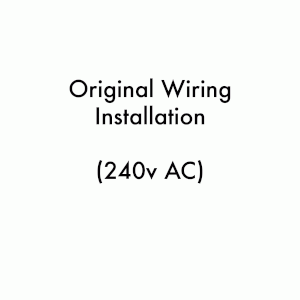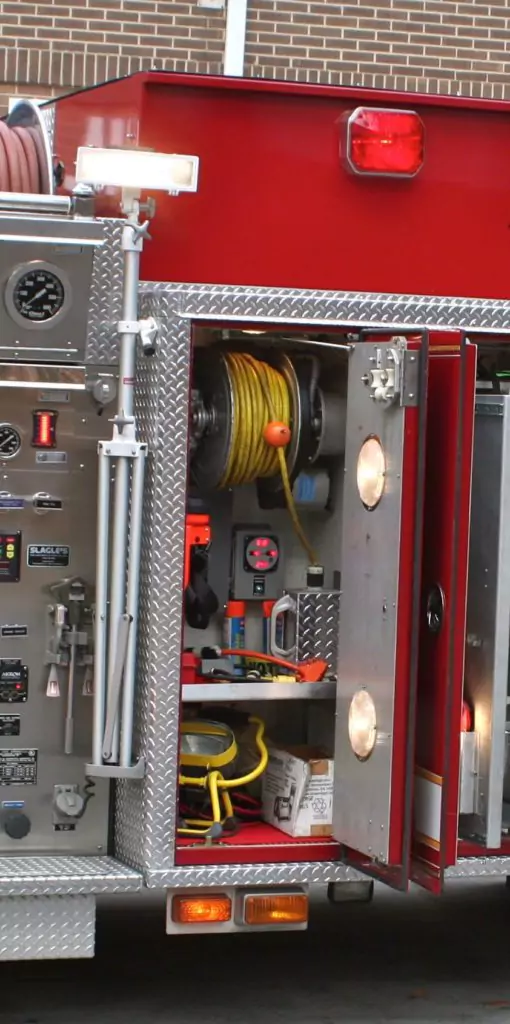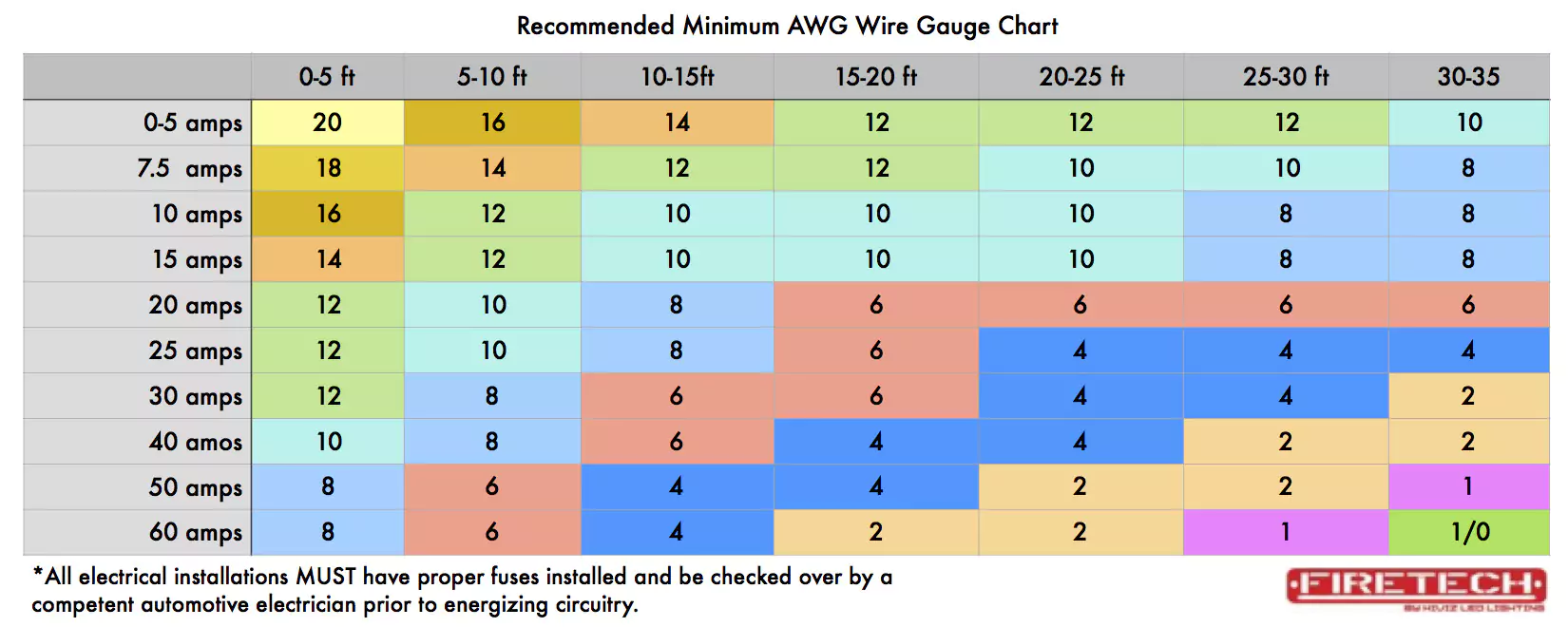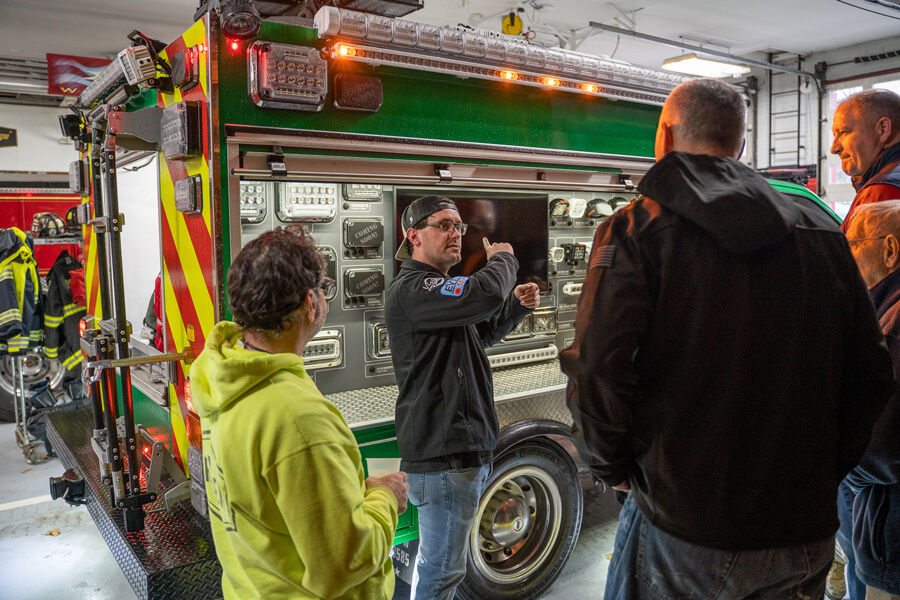By Sam Massa 12/26/2015
LED Scene Lighting Retrofit: Swapping old 120v/240v AC halogen fixtures to 12v DC LED fixtures
Many fire departments elect to swap their emergency vehicle lighting over from 120v/240v AC (generator powered) to 12v DC when doing an LED scene light retrofit. We see customers all the time who have large PTO generators on their apparatus with the sole purpose of firing the couple of 240v quartz scene lights placed around their trucks. While there are numerous benefits to having an apparatus with an on board generator, if it ever fails, the repair or replacement cost is often significantly higher than the cost of replacing the AC infrastructure with 12v LED scene lights.
An important consideration when converting scene lights from 120v AC fixtures to 12v DC fixtures is that it is not always possible to simply re-route and and re-use the old wiring attached to a new 12v power source. In simple terms, as voltage is decreased amperage is increased proportionally. Increased amperage in a wire that is too small will cause that wire to heat up and can cause a fire, in addition to loosing voltage as the power makes its way to the fixture. Too much voltage drop in the wiring will cause the light to operate incorrectly.
The amount of CURRENT the 12v DC fixtures draw, while still less WATTAGE is often significantly higher than the previous AC scene lights. They ARE still more efficient and still draw less power overall. There is a long technical explanation for why, but as firefighters or equipment installers the explanation does not matter as long as we know the above statement to be true.
So what!?
When customers see issues with their AC to DC retrofit installations, the great majority of the time, the problem can be directly attributed to the fact that the new load applied to the old circuit is drawing more current than the infrastructure was originally designed to support.
AC or DC power, the laws of physics are still the same. Watts divided by Volts equals Amps. Amps and the total distance from the battery or power source are the only numbers that really make a difference when designing the electrical system (and sizing the wiring appropriately).
The simple question to ask is “are the old wires I am planning to re-use heavy enough to support the current of the new system?” If you don’t know, check out this simple quick-reference chart to help you size your wire appropriately.
Here’s a hypothetical example for LED scene lights:
The HiViz LEDs Fire Department owns a 2001 Rescue truck with a 12kw 240v generator. On a call one night, the generator stopped working and after the mechanic looked at the truck, they were told it would require replacement. A new generator costs $15,000. The truck has 6 LED scene lights on it, each 1500w. They want to replace the 1,500w scene lights with the FT-SL-15 fixture but want to hook it up using DC power vs AC. The total fixture replacement cost is around $7,200 and the FD will be adding a 2kw suitcase generator for $1,500 for the odd jobs that require an AC power supply. The FD will save around $7,200 in equipment cost going this route and will eliminate their lighting maintenance cost if they install the solution correctly.
One of the guys on the lighting committee says he can just re-use the old wiring and can have the lights installed in an hour. An older member read this article and thinks otherwise. Here’s some math that would help them figure out if they need to run new wiring to the fixtures:
Watts/Volts=Amps
1500w fixture, divided by 240v = 6.25 Amps. The total wire run length is about 25’ to each fixture.
The FT-SL-15 will be operated at 12v. The fixture draws 150 watts.
150 watts divided by 12 volts equals 12.5 Amps per fixture- TWICE the amperage of the previous 1500w fixtures.
During manufacturing of the truck, the wiring that was installed to support the previous AC fixtures was most likely sized to match the 6.25A / fixture current draw. It is very likely the fire department would have issues with their installation if they simply re-used the wiring. They elect to take the truck to their local fire truck dealer and have all heavy-gauge wiring run for a total out the door cost of around $1,500. At the end of the day, the HiViz Fire Department was still able to save $5,700 and install a superior lighting solution with a lifetime warranty, compared to the $15,000 quoted cost to replace their broken PTO generator.
If you are interested in learning more about retrofitting LED Scene lights on your fire apparatus, check out our Scene Lighting products page or contact us to schedule a demo from one of our FireTech LED Scene lighting experts.
About HiViz LED Lighting
SAM MASSA is the President and Chief Technologist for HiViz LED Lighting, a manufacturer of specialty scene lighting equipment with a primary focus on the Fire and Emergency Services market. Sam is a North Carolina Firefighter / EMT and community contributor / active participant providing public commentation from the Scene Lighting industry to the NFPA 1901 technical committee. Sam has 11 years of entrepreneurial experience running small business and advising industries on technical topics ranging from Fuel Systems to LED Scene Lighting.
HiViz LED Lighting is located in Lillington, NC and is a member in good standing with the Fire Apparatus Manufacturer’s Association. For more information about how FireTech Brow Light, Scene Light, Work Lights, and Compartment Lighting solutions can be implemented in your fire department and on your fleet, contact HiViz LED lighting here.




